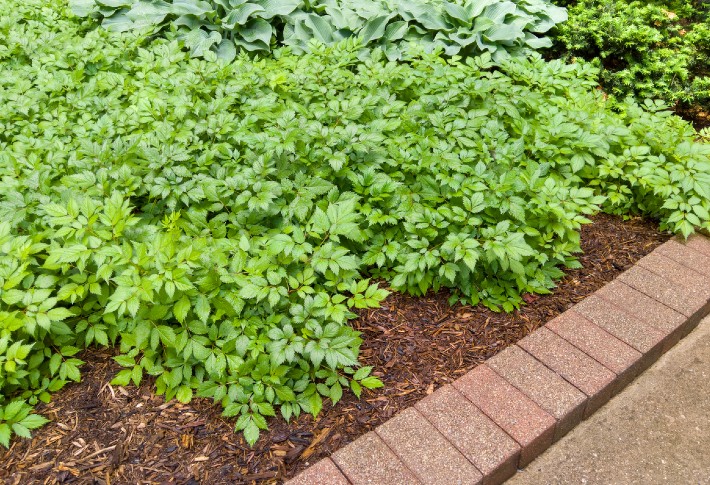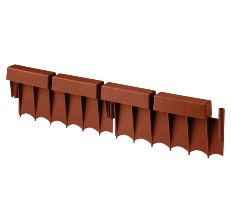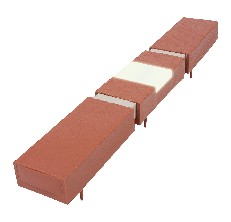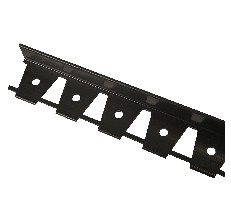- Flowers & PlantsVegetables
The Best Landscape Edging of 2024
Last updated: Mar 28, 2024
Do you not want to be that person who puts up "Keep off the grass" signs all over your yard but need to keep your lawn's edges secure from unwanted foot traffic? You should invest in landscape edging! Landscape edging puts up an effective barrier between your grass and sidewalks or borders. In this review guide, we will explore the best landscape edging of 2024, specifically brick edging. Brick edging provides a visually appealing and sturdy boundary line around your yard. The Suncast Landscape Edging is our number one pick for bridge edging, as it offers easy installation and versatility.
- Best Overall: Suncast Landscape Edging Shop Now ➔
- Runner Up: Argee Landscape Edging Shop Now ➔
- Honorable Mention: Dimex EasyFlex Landscape Edging Shop Now ➔
View all Contents- Find the Perfect Landscape Edging: A Buyer's Guide
- What Are the Different Types of Brick Edgings Available?
- What Are Some Key Considerations When Buying Brick Edgings?
- What Are Some Useful Tips To Remember When Buying High-Quality Landscape Edging?
- What Are the Different Variations of Landscape Edging Available on the Market?
- How Do I Install Brick Edgings?
- People Also Asked
The Best Landscape Edging
Best Overall
These cheap brick edgings offer rich features. Interlocking border edgings give a distinctive look. The plastics of these edgings are sturdy and feel premium. These border edgings are flexible and make it much easier to create curves around trees. And 90-degree corners around the bed of flowers as well.
Furthermore, these sun cast no-dig edgings are a lot easier to install just by using a mallet. When it comes to durability, these edgings give a long-lasting life with weatherproofing quality. This landscape brick edging has 60-feet in length. These brick edgings are the best option to enhance the beauty of your garden at a comparatively low cost.
Pros
- Easy to install
- Improves the overall look of the garden
- Flexible and versatile
Cons
- A bit more on the pricier side
Runner Up
These stylish edgings offer a pretty unique look. Its terra-cotta color gives an appealing look. Argee (RG840S) has 6 built-in lights and 50 regular plastic bricks. These “let’s edge it” edgings have a length of 40-feet with the capability of curving around things easily. The built-in lights allow you to glow the walkway at night.
A good quality plastic is used to provide extra strength. These well-constructed edgings look like new for several years. On top of that, to ensure ease of installation, no digging is required. You can just press them with your hands to install them. 56 plastic connectors and 2 end caps are also included in the box.
Pros
- Looks unique and stylish
- Amazing build quality
- No digging is required
Cons
- Only six lights included
Honorable Mention
Dimex easy flex gives a professional look to your garden without hiring a professional. These durable edgings offer a long-lasting border life around your concrete paths or paved patios etc. These are flexible enough that you can easily curve them by yourself just by cutting the spines.
To keep them in place, just do hammer anchoring spikes through the slots given in the Dimex edging. It isn’t as challenging as it looks. The plastic used in the Dimex easy flex is reliable. This is strong enough to hold the pavers in place. And the spikes are also made of plastic.
Pros
- Super sturdy and long-lasting
- Can curve around edges
- Has a professional look
Cons
- May not have enough spikes
Find the Perfect Landscape Edging: A Buyer's Guide
When it comes to the tools in your garden shed, such as blowers, mowers, and tillers, there are a few things to consider before making a purchase. The same applies to landscape edging. You may need additional help to find top-quality landscape edging since there is a lot to consider. That’s where this buying guide comes in. We’ll discuss one of the most popular types of landscape edging, which is brick edging, along with additional tips to help you find the right barrier to keep your lawn’s edges neat and well-maintained.
What Are the Different Types of Brick Edgings Available?
Clay brick edgings
Clay bricks are a form of brick that is both cost-effective and long-lasting, requiring little to no maintenance. If you choose, you can use cement and lime as materials.
Soft mud brick edgings
Soft mud bricks are created by pressing clay into sand-coated molds, resulting in a sanded face with small creases. This was once done by hand, but it is now more commonly done by machine.
Handmade brick edgings
Handmade bricks provide an authentic aesthetic if you wish to match existing bricks or build a home in a conservation area.
The clay is rolled in sand and then skillfully put into a mold by hand. Handmade variants have additional flexibility because they can be formed up of regular or nonstandard-sized bricks, instantly giving them a unique and beautiful appearance.
Reclaimed brick edgings
If you’re knocking down property and building a new one on the plot, you can use bricks reclaimed from the original building(s) to replicate the look or need to due to a planning condition.
Another good supply of used bricks is reclamation yards, but finding enough quantity and quality for a whole house or a significant extension might be challenging.
What Are Some Key Considerations When Buying Brick Edgings?
Resistance to slips
When you’re looking at your brick paver selections, this is a feature to keep in mind. For residential applications, slip resistance is essential, especially if people will be walking around barefoot on the patio after a rainstorm. With quality brick pavers made under today’s standards, you will find many options for minimizing slippage from your nearby pool or a spilled drink.
Ease of maintenance
Regular cleaning will allow your brick patio to age gracefully and develop a timeworn patina while preventing unsightly stains. You might seal the bricks to maintain a certain look for a brick patio that will look as good a decade from now as it does the day it is installed. The new patio will require regular cleaning. You should sweep away dirt and debris that could scratch the surface and have the patio power-washed regularly to remove tenacious stuck-on leaves.
Color choices
Although traditional brick red is still the most popular hue, the shade varies depending on where the brick was made. Brick pavers come in a variety of colors, such as charcoal grey and steel blue.
When your hardscaping professionals work with a renowned, high-quality manufacturer, you can count on the color to last the patio’s lifespan. Rather than sticking to one consistent color, a new approach to color is to combine multiple colors and tones on-site. Discuss the various alternatives with your landscaper, and ask to view samples in person at various times of the year.
What Are Some Useful Tips To Remember When Buying High-Quality Landscape Edging?
Think of the structural integrity
Which material you should choose depends on what you’re edging. A light-duty material, such as lumber, is all that is required for the lawn to border edging or pedestrian walkways. Plastic landscape edging is available at DIY stores, but it is typically difficult to install and looks cheap and unkempt.
Lightweight metal edging has come a long way and now comes in a wide range of thicknesses and designs, making it suited for a wide range of applications, from garden paths to driveways. Bricks on edge, pavers, and natural stone setts are generally preferred for heavy traffic and are chosen for their aesthetic qualities as well as their strength.
Consider aesthetic value
After ensuring that the edging is structurally sound, the next decision is whether to make it a design feature or leave it as subtle as possible. Because edging around beds is frequently concealed by plants, there seems little purpose in investing hundreds or even thousands of pounds in a material that will never be seen as long as it performs structurally.
The edging of a terrace or footpath may be just as important as the main body of material in terms of architectural integrity. Beautiful edging will complement beautiful paving, so if it is on display, let your imagination run wild. Allow it to contrast and complement, but keep it in scale with the rest of the room.
What Are the Different Variations of Landscape Edging Available on the Market?
Plastic
Plastic is the cheapest and possibly the most common landscape edging material because of its unique ability to tolerate corrosive conditions. It has pound-for-pound durability that many garden care professionals refer to, making it a flexible edging material for a variety of garden structures and conditions.
Plastic, on the other hand, does not fare well in extreme heat and dry conditions. Plastic tends to discolor and exhibit indications of wear after being exposed to the sun directly for an extended period, and it can become brittle in some cases.
Resin landscape edging material
Resin is similar to plastic in many ways; it is a polymer-based chemical, but it is primarily plant-based and hence considerably more environmentally friendly. However, some of the less expensive resins are treated with a variety of synthetic and plastic components, such as petrochemicals, to increase their durability and longevity.
Extreme heat, on the other hand, does not affect resins. Because of their particular coating, they are far less prone to melt, but (here’s the interesting bit) this same coating makes the resin much more brittle than plastic in freezing temperatures.
Classic wood brick-designed edgings
Nothing screams tradition more than using wood for your garden edging. Wood has been used as a land area demarcating material since the birth of civilization, and while it was once only available to the nobles, it is now widely available to all householders.
Wooden edging is also very common in a lot of suburban communities. One interesting feature of wood is that if you plant a lot of trees in your yard, you can build your lawn edge out of them. However, if you want to purchase them from a store, wood might be significantly more expensive than both plastic and resin.
Stainless steel-based landscape edging
When it comes to metals, stainless steel is the most popular choice for all types of lawn and garden edging. But keep in mind that you shouldn’t just go with steel; the kind should be stainless, and it’s best to have it powder-coated to ensure that it lasts a long time.
If stainless steel isn’t coated, it won’t be able to survive water’s corrosive effects very well. It will surely rust quickly and become more brittle as time passes (rust will form after many years, even if it is coated; coating simply extends the lifespan).
Aluminum landscape edging
If cost is not a concern when it comes to edging your lawn, an aluminum landscape edging device would be the ideal alternative. It’s one of the most adaptable bases available, combining all of the benefits of the preceding materials while omitting all of the drawbacks.
Temperatures, no matter how high or low, do not affect the structural integrity of the aluminum. It doesn’t fracture or melt, and although it isn’t as visible, it is theoretically more durable than stainless steel, with a far higher melting and freezing temperature.
How Do I Install Brick Edgings?
Home Depot has put together an all-informative video on how to install brick edgings. It’s a great place for an amateur bricklayer to get started.
People Also Asked
Is paver edging really necessary?
Any paver project would be incomplete without edging. Your pavers will be far more prone to spread and sink if you don't use them. You should have edging installed around the perimeter of your pavers unless they are installed with the edges touching another solid surface (a curb, driveway edge, or a wall).
Is it possible to install bricks in the soil?
Yes, it is possible. Using pegs and string, mark the path's outline. Along the path's length, dig 180mm into the dirt. With a rubber mallet, pound your bricks into the soil, leaving 20mm between them.
Is plastic landscape edging durable enough?
Just about any plastic landscape edging should be robust and durable enough, as long as it is installed properly. The height of the grass edges is the most important consideration.
Article Contributors
Read More About Garden Gate Review Team HereThe Garden Gate Review Team’s product reviews and in-depth guides are here to help you choose the best products for a beautiful and bountiful garden and backyard. The content is created by The Garden Gate Review Team. Garden Gate’s editorial staff is not involved. Garden Gate is reader-supported: When you buy through links on our site, we may earn an affiliate commission. The Garden Gate Review Team is composed of authors, editors, and gardeners. Artificial Intelligence (large language models) may have been used in the research and creation of the content.
Please reach out to aimperiapt@gmail.com with any questions regarding product testing or specific articles.



